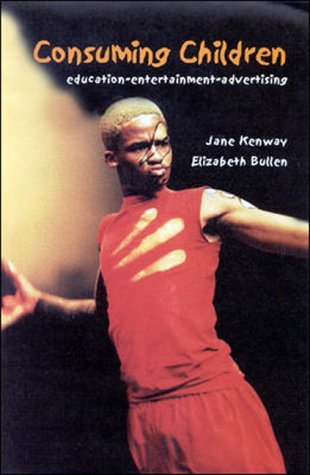Consuming Children: Education-Entertainment- Advertising
Jane Kenway and Elizabeth Bullen
Open University Press: Buckingham
1999
0335202993 (pb); 0335203000 (hb)
£154.99 (pb); £45.00 (hb)
160
 Presenting a child-centred account of the rising tide of children's mass consumer culture, and the increasing marketisation of education, Consuming Children argues for a new pedagogy to meet the needs of education in the 'age of desire'. Arguing that we are entering a new phase in the construction of childhood, Kenway and Bullen explore themes such as the changing dynamic of relations between adults and children, teachers and pupils, and between education and consumer media culture.
Presenting a child-centred account of the rising tide of children's mass consumer culture, and the increasing marketisation of education, Consuming Children argues for a new pedagogy to meet the needs of education in the 'age of desire'. Arguing that we are entering a new phase in the construction of childhood, Kenway and Bullen explore themes such as the changing dynamic of relations between adults and children, teachers and pupils, and between education and consumer media culture.
The central themes are explored through an extensive literature reviewˇencompassing sociology, anthropology, cultural studies, education studies, psychology, and trade journalsˇand through participant observation and interviews. Indeed, it is the interdisciplinarity of the study, and the use of primary sources to illustrate and reinforce theoretical understanding, that provides its most refreshing and challenging aspects; 'theoretical promiscuity' (p.3) it may be, but it manages to hang together and in a language that is at once accessible and thought-provoking.
'Devouring Theory' provides an excellent introduction for those engaged in consumption studies, anthropology or media studies; they trace the origin and development of consumer-media culture, and outline the main approaches to the study of consumption, relying heavily on Featherstone, but also discussing European Marxism, Critical Theory, the Frankfurt School, Jameson, Baudrillard, Bourdieu and Kristera.
In 'Inventing the Young Consumer' the authors look at the way conceptions of childhood have changed; from the 'shrunken adults' of medieval times to the separated, segmented, fragmented and agential consumers of the present. They discuss the way that different age-groups have been constructed by advertisers, the separation of the 'youth' market from those of children and adults, and the rise of gender specific child marketing'.
'Polarizing Pleasures' explores the way that youth culture has been subject to the dissolution of the boundaries between education, advertising and entertainment and - with cartoons such as Pokémon serving as feature length commercials for the associated merchandise - and yet also been subject to increased market segmentation. As children are offered empowerment through consumption, adults are encouraged to extend their adolescence by indulging in libidinous pleasures; selling to children as a separate market whilst simultaneously collapsing the boundaries between generations.
'Promiscuous Corporations' charts the rationale behind the commercial targeting of education, its implications and the responses of schools; alerting head teachers to the 'hidden curriculum' of commercial involvement and highlighting the role of consumption in identity formation. The authors also discuss the need to encourage pupils to develop their critical capacity for a 'sociological reading of how they and their social relationships are constructed within this semiosis' (p. 119).
In 'Designer Schools, Packaged Students' the authors explore the relational implications of the marketisation of education; arguing that this process both 'de-traditionalises' and 're-traditionalises' education, reinforcing power matrices between parents and children, and between teachers and pupils, leaving school on the margins of children's identities.
The final two chapters provide an outline of a pedagogy that seeks to both re-engage children with education, and provide them with a 'critical stance' toward their own consumption. Combining the tactics of anti-corporate activism and the 'successful' aspects of corporate pedagogy - its ability to provide children with multiple subject positions - the authors call for 'consumer-media education' which subverts and reverses marketing and media strategies. They argue that this pedagogy would show students how they are both used by, and in turn use marketing media; by recognising student agency, their investment in consumption and by encouraging them to look behind the surface of advertising students could develop 'authentic' reflexivity.
In places Consuming Children reads like a glossy magazine advert, with its at times annoying use of corporate jargon, and playful use of language. Their unproblematic acceptance of the democratic nature of the Internet undermines their call for the 'youthful cyberflâneur', and raises further issues as to how it would be possible to direct pupils thoughts whilst simultaneously levelling the relationship between pupils and teachers; surely, agential pupils cannot have their thoughts directed? Would there be limits imposed regarding internet access, or would pupils be allowed access to even the most unsavoury of sites? How would over-worked teachers be able to 'teach to the test' while encouraging transgressive behaviour? Some may wonder as to the theoretical implications of Kenway and Bullen's theoretical and methodological promiscuity, or worry that the pedagogic approach outlined here does little to address the question of consumption itself. Also, would corporations be keen to provide materials or sponsorship to schools if aware that consumer-media teachers would be using them to provide an insight into the 'night-time' of the commodity?
Perhaps most interesting is their positioning of children as the vanguards of history, despite the authors decidedly post-modern stance, who through their 'proximity' to consumer-media culture are uniquely able to both perceive and change the social order. Consuming Children raises more questions than it answers, but then that is the mark of a good book. It is a must for those studying in this field, and for those with an interest in education, youth culture or consumption studies.
Wendy Ashall
University of Sussex

